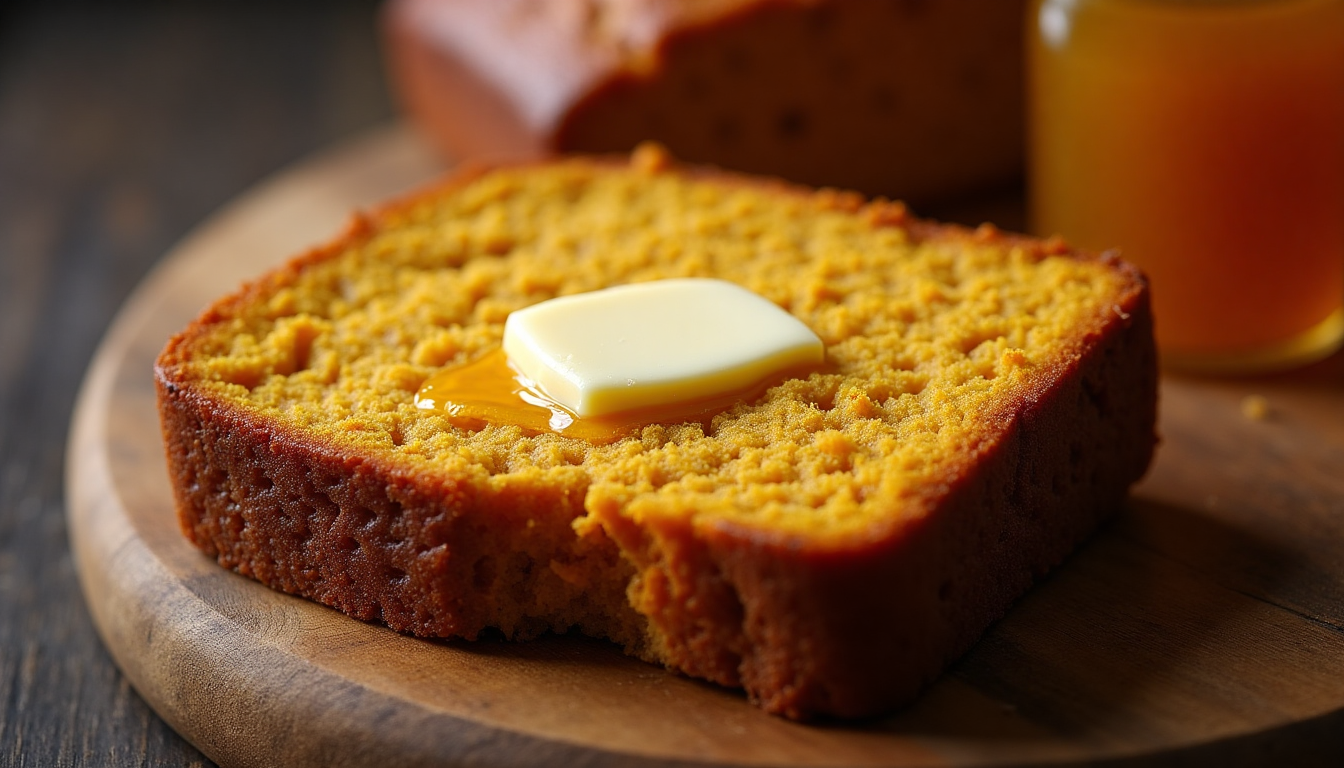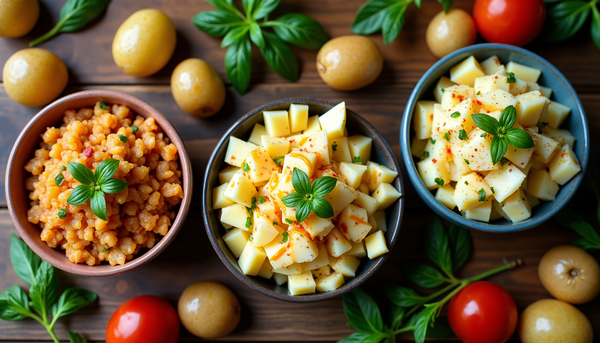Why Your Pumpkin Cornbread Game is All Wrong (And How to Fix It)

Okay, let's talk about pumpkin cornbread. Actually, let's talk about how everyone is doing pumpkin cornbread wrong.
I know, I know – that's a bold statement coming from someone who once accidentally made cornbread soup because I forgot to measure my liquids properly. But hear me out.
The Great Pumpkin Spice Conspiracy
We've been brainwashed, people. The moment October hits, we start dumping cinnamon, nutmeg, allspice, and cloves into everything orange like we're trying to recreate a Starbucks fever dream. But here's the thing about pumpkin that nobody wants to admit: it's not naturally sweet. It's earthy. It's subtle. It's got this beautiful, almost savory quality that gets completely bulldozed by our pumpkin spice obsession.
Last month, I was at my friend's dinner party – you know, one of those "casual" gatherings where everyone brings their A-game dishes and pretends they didn't stress-cook for three days straight. Sarah brought her "famous" pumpkin cornbread, and honestly? It tasted like someone had emptied a spice cabinet into orange cake mix. Don't get me wrong, Sarah's lovely, but her cornbread was having an identity crisis.
That's when I realized we've been approaching this all wrong.
The Real Magic: Brown Butter + Restraint
Here's what I discovered after about fifteen failed attempts (and one minor kitchen fire – don't ask): the secret isn't more spice. It's better fat and understanding what pumpkin actually brings to the party.
Enter: brown butter.
If you've never browned butter before, you're missing out on one of cooking's greatest magic tricks. It's like the difference between a regular lightbulb and one of those fancy warm Edison bulbs – same basic concept, completely different vibe. When you heat butter past its melting point and keep going until the milk solids turn golden and nutty, something transcendent happens.
The process is simple but requires your full attention (unlike regular melting where you can scroll Instagram and somehow not burn your house down). You heat the butter in a pan, it foams, it bubbles, and then – if you're watching carefully – it starts smelling like heaven mixed with toasted hazelnuts. The milk solids turn golden brown, and suddenly you have this complex, nutty, magical fat that makes everything taste like it came from a fancy bakery.
Why This Combination Actually Works (Science-y Stuff)
Pumpkin purée adds moisture – like, serious moisture – without being heavy. It's got this subtle sweetness that plays beautifully with cornmeal's natural earthiness. When you add browned butter to the mix, you get this holy trinity of:
- Earthy (pumpkin + cornmeal)
- Nutty (browned butter)
- Sweet (just a touch of honey – because refined sugar is for quitters)
The texture? Chef's kiss. The pumpkin keeps everything tender while the cornmeal maintains that slightly gritty texture that makes cornbread actually cornbread and not just yellow cake pretending to be Southern.
And here's where I get a little controversial: I only use a tiny bit of cinnamon. Like, barely-there amounts. Because when you let the pumpkin and browned butter do their thing without interference, the result is so much more sophisticated than your typical fall-flavored everything.
The Technique (Where Most People Mess Up)
Okay, let's get technical for a hot second. Making this cornbread isn't difficult, but there are a few spots where things can go sideways:
Brown Butter Timing: This is where people panic. You want to watch the butter like you're binge-watching your favorite show – constant attention but not stressed about it. It'll foam, the foam will subside, and then you'll start seeing golden bits at the bottom. When it smells nutty (you'll know), immediately pour it into a bowl. Don't leave it in the hot pan because it'll keep cooking and turn bitter faster than you can say "expensive mistake."
Mixing Method: Dry ingredients first, create a well, add your liquids. This isn't a muffin situation where you barely stir – you want everything combined, but you're not trying to develop gluten like you're making bread. Think "enthusiastic folding" rather than "aggressive beating."
The Pumpkin Factor: Use actual pumpkin purée, not pumpkin pie filling. I learned this the hard way when my first attempt tasted like someone had liquified a candle. Pure pumpkin gives you that earthy sweetness without the pre-seasoned chaos.
Where to Take This Next
Here's where it gets fun – this recipe is like a really good base coat. It's perfect on its own, but it's also begging to be customized:
Savory Route: Add sharp cheddar and fresh thyme. Trust me on this. The combination of nutty brown butter, earthy pumpkin, and sharp cheese is ridiculous in the best way. Serve it with chili or soup, and people will ask for your contact information.
Fancy Route: Fold in toasted pecans and a drizzle of maple syrup. This version shows up to Thanksgiving dinner wearing a tuxedo.
Breakfast Route: Add a handful of dried cranberries and serve with actual butter (or better yet, honey butter – because we're not monsters).
Cast Iron Adventure: If you want to feel like you're channeling your great-grandmother's kitchen skills, make this in a cast-iron skillet. Brown the butter right in the skillet, transfer it out, heat the empty skillet in the oven, then pour the batter into the hot pan. The bottom gets this incredible crust that'll make you question every other cornbread you've ever eaten.
Real Talk: What to Expect
This isn't going to taste like those super-sweet, cake-y cornbreads you might be used to. It's more sophisticated than that – the kind of cornbread that makes people pause mid-conversation and ask what you did differently. The pumpkin adds this subtle richness without screaming "FALL FLAVORS" at everyone within a five-mile radius.
The texture is what really gets people though. It's tender but still has that cornmeal bite. It's moist but not dense. It's sweet but not dessert-sweet. Basically, it's everything you want cornbread to be but didn't know how to achieve.
Your Turn to Experiment
Here's what I want you to try: make this recipe exactly as written first. Don't get creative yet (I know, it's hard). Taste it. Notice how the flavors work together. Then, next time, try one modification. Maybe add cheese. Maybe try it in a cast iron pan. Maybe experiment with different honey varieties (wildflower vs. clover makes more difference than you'd think).
And here's my challenge for you: bring this to your next gathering and don't tell people there's pumpkin in it. Just say it's "special cornbread" and watch people try to figure out what makes it so good.
Quick question for the comments: What's your biggest cornbread disaster? I showed you mine (cornbread soup, remember?), now it's your turn. Also, are you team sweet cornbread or team savory cornbread? Because this recipe might just convert you to team "why-choose-when-you-can-have-both."
The recipe itself is pretty straightforward – brown butter, mix dry ingredients, combine everything without overthinking it, bake until golden. But the result? That's where the magic happens. Trust the process, trust the brown butter, and prepare to ruin regular cornbread for yourself forever.
Fair warning: once you start browning butter for everything, there's no going back. You've been warned.




